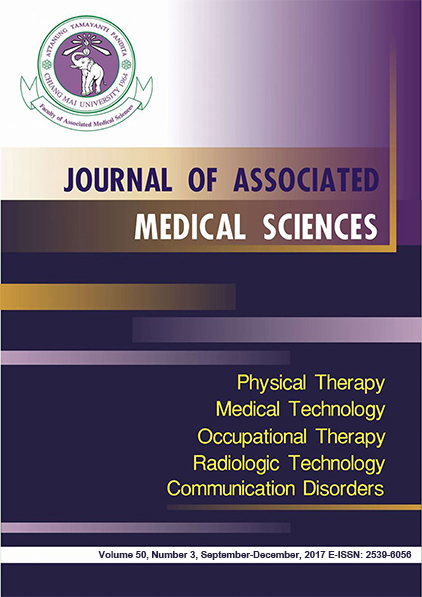A Survey of risk for developing dementia in community dwelling elderly in Chiang Mai and Lampoon
Main Article Content
Abstract
Background: With increasing number of elderly people in Thailand, the number of elderly at risk of dementia is increased accordingly. Prevalence of dementia for those living in community is needed information for health promotion and prevention of dementia.
Objectives: To investigate prevalence of dementia in elderly community dwellers living in Chiang Mai and Lampoon.
Materisls and methods: Montreal Cognitive Assessment (MoCA), Thai version was used as a tool. Five communities including Maekha, San Kamphaeng, Sanklang, Nong Kaeo, Nong Khwai and Ma Kok were explored. One hundred and seventy six elderly persons participated in the study.
Results: It was shown that 95.4% of participants were at risk for dementia. The prevalence reported from Maekha, Sanklang and Nong Kaeo were 97.7&, 96.7&% and 91.9%, respectively where Nong Khwai and Ma Kok were similar of 95.2%.
Conclusion: All in all, there is a high prevalence of dementia in these community
Article Details
Personal views expressed by the contributors in their articles are not necessarily those of the Journal of Associated Medical Sciences, Faculty of Associated Medical Sciences, Chiang Mai University.
References
National Statistical Office. Survey of elderly population in Thailand 2014. National Statistical Office, 2014 (in Thai)
Aekplakorn W, Porapakkham Y, Taneepanichsku S, Puckcharern H, Satheannoppakao W, Thaikla K. Thai National Health Examination. Survey, NHES V. Nonthaburi: Health System Research Institute, 2010. (in Thai)
Melin E, Thunander M, Landin-Olsson M, Hillman M, Thulesius H. Depression, smoking, physical inactivity and season independently associated with midnight salivary cortisol in type 1 diabetes. BMC Endocr Disord. 2014; 14:75.(doi):10.1186/472-6823-14-75.
WHO. World Health Report 2003—Shaping the future. Geneva: World Health Organization 2003.
Prince M, Knapp M, Guerchet M, McCrone P, Prina M, Comas-Herrera A, et al. The cost of dementia. Alzheimer’s Society, Dementia UK: Update Second edition. London: Alzheimer’s Society Public Policy; 2014. p. 42-61.
Ministry of Public Health. Strategy Index and Guideline for Data collection: Ministry of Public Health Budget year 2015. Bangkok: Ministry of Public Health. (in Thai)
Wongchan P. New paradigm for community services. In Wongchan P. (ed.). Memorial for 40th year Faculty of Associated Medical Sciences, Chiang Mai University. Chiang Mai: Triple group Co. Ltd. 2015. (in Thai)
Richards F, Coope B. ABC of dementia. Chichester, West Sussex: John Wiley & Sons Inc; 2014.
Biessels G. Diagnosis and treatment of vascular damage in dementia. Biochim Biophys Acta 2015.
Tiraboschi P, Hansen L, Thal L, Corey-Bloom J. The importance of neuritic plaques and tangles to the development and evolution of AD. Neurology. 2004; 62(11):1984-9.
WHO. International Classification of Diseases (ICD) 2010 30 March 2016.
American Psychiatric Association. Diagnostic and Statistical Manual of Mental Disorders, 5th Edition: DSM-5 Washington, DC: American Psychiatric Association; 2013. 947 p.
Lucza T, Karádi K, Kállai J, Weintraut R, Janszky J, Makkos A, et al. Screening Mild and Major Neurocognitive Disorders in Parkinson’s Disease. Behavi Neurol. 2015; 2015:10.
Liew T, Feng L, Gao Q, Ng T, Yap P. Diagnostic utility of Montreal Cognitive Assessment in the Fifth Edition of Diagnostic and Statistical Manual of Mental Disorders: major and mild neurocognitive disorders. J Am Med Dir Assoc. 2015;16(2):144-8. doi: 10.1016/j.jamda.2014.07.021. Epub Oct 3.
Baginda AM. The role of non-governmental organizations for activity involving the elderly in the mainstream of economic and social development: Productive Ageing in Asia and the Pacific. New York: United Nation, 1992.
Nasreddine Z, Phillips NA, Bédirian V, Charbonneau S, Whitehead V, Collin I, et al. The Montreal Cognitive Assessment, MoCA: a brief screening tool for mild cognitive impairment. J Am Geriatr Soc. 2005; 53(4):695-9.
Hemrungroj S. Montreal Cognitive Assessment (MoCA) Thai version. 2009 1 September 2015]. Available from: http://www.cueid.org/content/view/2764/78. (in Thai)
Strout K, Howard E. The six dimensions of wellness and cognition in aging adults. J Holist Nurs. 2012; 30(3):195-204. Epub 2012 Jun 19.
Ng T, Feng L, Lim W, Chong M, Lee T, Yap K, et al. Montreal Cognitive Assessment for screening mild cognitive impairment: variations in test performance and scores by education in Singapore. Dement Geriatr Cogn Disord. 2015; 39(3-4):176-85. doi: 10.1159/000368827. Epub 2015 Jan 6.
Tan J, Li N, Gao J, Wang L, Zhao Y, Yu B, et al. Optimal cutoff scores for dementia and mild cognitive impairment of the Montreal Cognitive Assessment among elderly and oldest-old Chinese population. J Alzheimers Dis. 2015; 43(4):1403-12. doi: 10.3233/JAD-141278


